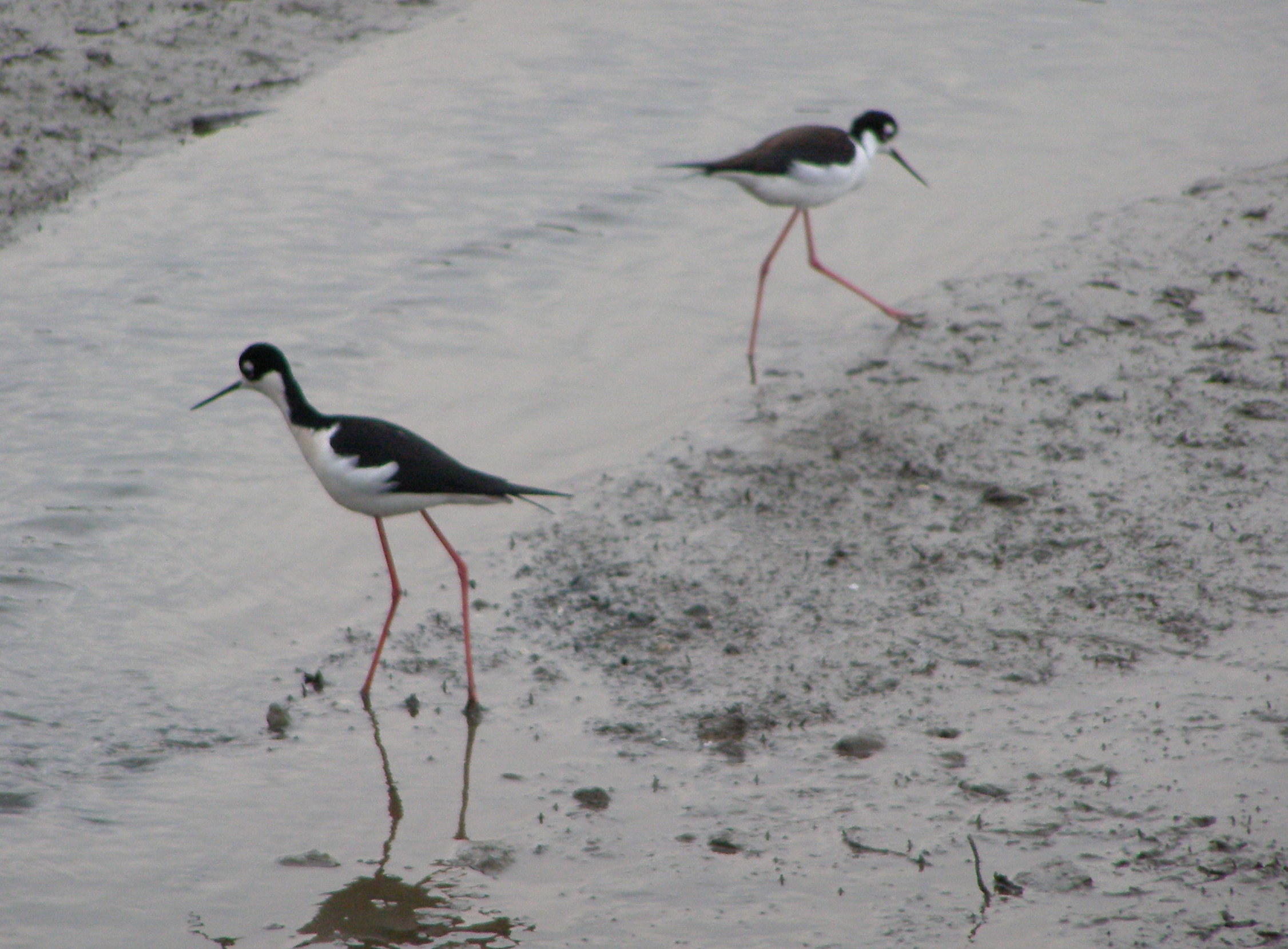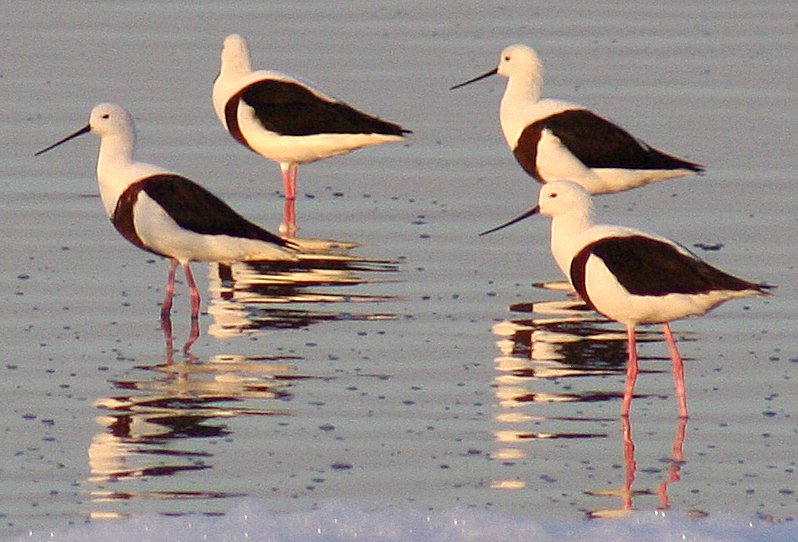|
Himantopus
Stilt is a common name for several species of birds in the family Recurvirostridae, which also includes those known as avocets. They are found in brackish or saline wetlands in warm or hot climates. They have extremely long legs, hence the group name, and long thin bills. Stilts typically feed on aquatic insects and other small creatures and nest on the ground surface in loose colonies. Most sources recognize 6 species in 2 genera, although the white-backed and Hawaiian stilts are occasionally considered subspecies of the black-necked stilt. The genus ''Charadrius'' was introduced by the French zoologist Mathurin Jacques Brisson in 1760 with the black-winged stilt (''Himantopus himantopus'') as the type species. The generic name ''Himantopus'' comes from the Ancient Greek meaning "strap-leg". Species The genus ''Himantopus'' contains five species: * Black-winged stilt, ''Himantopus himantopus'' * White-backed stilt, ''Himantopus melanurus'' * Pied stilt, ''Himantopus le ... [...More Info...] [...Related Items...] OR: [Wikipedia] [Google] [Baidu] |
Black-winged Stilt
The black-winged stilt (''Himantopus himantopus'') is a widely distributed, very long-legged wader in the avocet and stilt family Recurvirostridae. Its scientific name, ''Himantopus himantopus'', is sometimes used to generalize a single, almost cosmopolitan species. Alternatively, it is restricted to the form that is widespread in Europe, Asia and Africa, which equals the nominate group of ''H. himantopus'' ''sensu lato''. Meanwhile, the black-necked (''H. mexicanus'') and white-backed stilts (''H. melanurus'') both inhabit the Americas; the pied stilt (''H. leucocephalus'') ranges from Australasia and New Zealand. Today, most sources accept between one and four actual species. Taxonomy The black-winged stilt was formally described in 1758 by the Swedish naturalist Carl Linnaeus in the tenth edition of his ''Systema Naturae''. He placed it with the plovers in the genus ''Charadrius'' and coined the binomial name ''Charadrius himantopus''. He specified the type locality as ... [...More Info...] [...Related Items...] OR: [Wikipedia] [Google] [Baidu] |
Black-necked Stilt
The black-necked stilt (''Himantopus mexicanus'') is a locally abundant shorebird of North and South American wetlands and coastlines. It is found from the coastal areas of California through much of the interior western United States and along the Gulf of Mexico as far east as Florida, then south through Central America and the Caribbean to Brazil, Peru and the Galápagos Islands, with an isolated population, the Hawaiian stilt, in Hawaii. The northernmost populations, particularly those from inland, are migratory, wintering from the extreme south of the United States to southern Mexico, rarely as far south as Costa Rica; on the Baja California peninsula it is only found regularly in winter. Some authorities, including the IUCN, treat it as a synonym of ''Himantopus himantopus''. Taxonomy It is often treated as a subspecies of the common or black-winged stilt, using the trinomial name ''Himantopus himantopus mexicanus''. However, the American Ornithological Society, AOS has al ... [...More Info...] [...Related Items...] OR: [Wikipedia] [Google] [Baidu] |
Hawaiian Stilt
The Hawaiian stilt (''Himantopus mexicanus knudseni'') is an endangered Hawaiian subspecies of the black-necked stilt (''H. mexicanus'') species. It is a long-legged, slender shorebird with a long, thin beak. Other common names include the Hawaiian black-necked stilt, the aeʻo (from a Hawaiian name for the bird and word for stilts), the kukuluaeʻo (a Hawaiian name for the bird and word for “one standing high”), or it may be referred to as the Hawaiian subspecies of the black-necked stilt. Taxonomy The Hawaiian stilt is usually classified as a subspecies of the black-necked stilt, ''Himantopus mexicanus knudseni'', or sometimes as a full species, ''Himantopus knudseni''. Description The Hawaiian stilt grows up to in length. It has a dark back from head to tail, with a white forehead, face, and underside. Its bill is thin, long and black, and its legs are very long and pink. They are sexually dimorphic, differing in the colour and lustre of their back feathers. Females hav ... [...More Info...] [...Related Items...] OR: [Wikipedia] [Google] [Baidu] |
Black Stilt
The black stilt (''Himantopus novaezelandiae'') or kakī (Māori language, Māori) is a wading bird found in New Zealand. It is one of the world's rarest birds, with 169 adults surviving in the wild as of May 2020. Adult kakī have distinctive black plumage, long pink legs, and a long thin black bill. Black stilts largely breed in the Mackenzie Basin in the South Island, and are threatened by introduced Cats in New Zealand, feral cats, ferrets, and hedgehogs as well as habitat degradation from hydroelectric dams, agriculture, and invasive weeds. Taxonomy and systematics Black stilts are one of several species in the genus Stilt, ''Himantopus'', classified along with avocets in the family Recurvirostridae. Although genetically and behaviourally distinct from Black-winged stilt, pied stilts (''Himantopus himantopus''), they are able to successfully hybridise with them. Hybridisation and dilution of the gene pool is one reason black stilts are threatened with extinction. Black an ... [...More Info...] [...Related Items...] OR: [Wikipedia] [Google] [Baidu] |
Recurvirostridae
The Recurvirostridae are a family of birds in the wader suborder Charadrii. It contains two distinct groups of birds, the avocets (one genus) and the stilts (two genera). Description Avocets and stilts range in length from and in weight from ; males are usually slightly bigger than females. All possess long, thin legs, necks, and bills. The bills of avocets are curved upwards, and are swept from side to side when the bird is feeding in the brackish or saline wetlands they prefer. The bills of stilts, in contrast, are straight. The front toes are webbed, partially in most stilts, and fully in avocets and the banded stilt, which swim more. The majority of species' plumage has contrasting areas of black and white, with some species having patches of buff or brown on the head or chest. The sexes are similar. Their vocalizations are usually yelps of one or two syllables. Distribution and habitat Avocets and stilts are a cosmopolitan distribution, cosmopolitan family, being distri ... [...More Info...] [...Related Items...] OR: [Wikipedia] [Google] [Baidu] |
Pied Stilt
The pied stilt (''Himantopus leucocephalus''), also known as the white-headed stilt, is a shorebird in the Family (biology), family Recurvirostridae. It is widely distributed with a large total population size and apparently stable population trend, occurring in Malaysia, Japan, the Philippines, Brunei, Christmas Island, Indonesia, Palau, Papua New Guinea, Australia, and New Zealand. It is listed as Least Concern on the IUCN Red List. It is sometimes considered a subspecies of the black-winged stilt (''H. himantopus''). Taxonomy ''Himantopus leucocephalus'' was the scientific name proposed by John Gould in 1837 who described a pied stilt from Australia. Description The pied stilt grows to a length of about with a wingspan of about . The back of the head and neck, the back and the upper surfaces of the wings are glossy greenish-black. The undersides of the wings are plain black and the remainder of the plumage is white, apart from the tail feathers which are tinged with grey. T ... [...More Info...] [...Related Items...] OR: [Wikipedia] [Google] [Baidu] |
White-backed Stilt
The white-backed stilt (''Himantopus melanurus'') is a locally abundant shorebird of South American wetlands and coastlines. It is found from northwest Brazil to southwest Peru and southcentral Argentina. Taxonomy It is sometimes treated as a subspecies of the common or black-winged stilt, using the trinomial name ''Himantopus himantopus melanurus''. The AOS considers it a subspecies of the black-necked stilt, where it is considered parapatric and intergrading to some extent with its northern relative where their ranges meet, and would warrant inclusion with the black-necked stilt when this is separated specifically. Distribution and habitat The white-backed stilt is found in estuarine, lacustrine, salt pond and emergent wetland habitats; it is generally a lowland bird but is commonly seen in llanos habitat. Food and feeding The white-backed stilt forages by probing and gleaning primarily in mudflats and lakeshores, but also in very shallow waters near shores; it seeks out a ... [...More Info...] [...Related Items...] OR: [Wikipedia] [Google] [Baidu] |
Banded Stilt
The banded stilt (''Cladorhynchus leucocephalus'') is a Bird migration#Short-distance and altitudinal migration, nomadic wader of the stilt and avocet family, Recurvirostridae, native to Australia. It belongs to the monotypic genus ''Cladorhynchus''. It gets its name from the red-brown breast band found on breeding adults, though this is mottled or entirely absent in non-breeding adults and juveniles. Its remaining plumage is Piebald, pied and the eyes are dark brown. Nestling banded stilts have white down, unlike any other species of wader. Breeding is triggered by the filling of inland salt lakes by rainfall, creating large shallow lakes rich in tiny shrimp on which the birds feed. Banded stilts migrate to these lakes in large numbers and assemble in large breeding colonies. The female lays three to four brown- or black-splotched whitish Bird egg, eggs on a Bird nest#Scrape, scrape. If conditions are favourable, a second brood might be laid, though if the lakes dry up prematur ... [...More Info...] [...Related Items...] OR: [Wikipedia] [Google] [Baidu] |
Genus
Genus (; : genera ) is a taxonomic rank above species and below family (taxonomy), family as used in the biological classification of extant taxon, living and fossil organisms as well as Virus classification#ICTV classification, viruses. In binomial nomenclature, the genus name forms the first part of the binomial species name for each species within the genus. :E.g. ''Panthera leo'' (lion) and ''Panthera onca'' (jaguar) are two species within the genus ''Panthera''. ''Panthera'' is a genus within the family Felidae. The composition of a genus is determined by taxonomy (biology), taxonomists. The standards for genus classification are not strictly codified, so different authorities often produce different classifications for genera. There are some general practices used, however, including the idea that a newly defined genus should fulfill these three criteria to be descriptively useful: # monophyly – all descendants of an ancestral taxon are grouped together (i.e. Phylogeneti ... [...More Info...] [...Related Items...] OR: [Wikipedia] [Google] [Baidu] |
Type Species
In International_Code_of_Zoological_Nomenclature, zoological nomenclature, a type species (''species typica'') is the species name with which the name of a genus or subgenus is considered to be permanently taxonomically associated, i.e., the species that contains the biological Type (biology), type wiktionary:en:specimen, specimen (or specimens). Article 67.1 A similar concept is used for suprageneric groups and called a type genus. In botanical nomenclature, these terms have no formal standing under the International Code of Nomenclature for algae, fungi, and plants, code of nomenclature, but are sometimes borrowed from zoological nomenclature. In botany, the type of a genus name is a specimen (or, rarely, an illustration) which is also the type of a species name. The species name with that type can also be referred to as the type of the genus name. Names of genus and family ranks, the various subdivisions of those ranks, and some higher-rank names based on genus names, have suc ... [...More Info...] [...Related Items...] OR: [Wikipedia] [Google] [Baidu] |
Ancient Greek
Ancient Greek (, ; ) includes the forms of the Greek language used in ancient Greece and the classical antiquity, ancient world from around 1500 BC to 300 BC. It is often roughly divided into the following periods: Mycenaean Greek (), Greek Dark Ages, Dark Ages (), the Archaic Greece, Archaic or Homeric Greek, Homeric period (), and the Classical Greece, Classical period (). Ancient Greek was the language of Homer and of fifth-century Athens, fifth-century Athenian historians, playwrights, and Ancient Greek philosophy, philosophers. It has contributed many words to English vocabulary and has been a standard subject of study in educational institutions of the Western world since the Renaissance. This article primarily contains information about the Homeric Greek, Epic and Classical periods of the language, which are the best-attested periods and considered most typical of Ancient Greek. From the Hellenistic period (), Ancient Greek was followed by Koine Greek, which is regar ... [...More Info...] [...Related Items...] OR: [Wikipedia] [Google] [Baidu] |






